#bengali folklore
Text
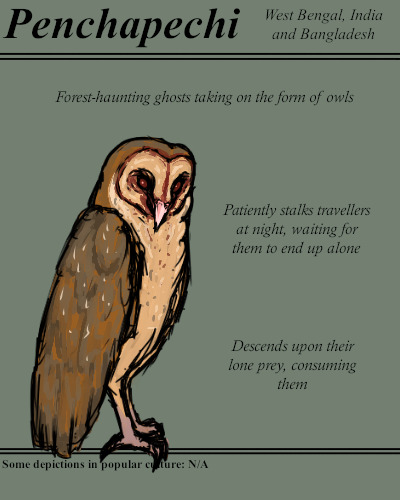
Flesh-eating, blood-draining ghosts. Horrible spirits that are just another reason to avoid being alone in forests at night.
#BriefBestiary#bestiary#digital art#fantasy#folklore#legend#myth#mythology#ghost#penchapechi#forest monster#monster#bengali folklore#bengali legend#bengali ghost
20 notes
·
View notes
Text
youtube
#Bengali alphabet#Bangladeshi culture#Bengali script#Bangladesh history#Dhaka city#Bengali literature#Bangladesh cuisine#Bengali music#Bangladesh tourism#Bengali poetry#Bengali tradition#Bangladeshi art#Bangladesh economy#Bengali heritage#Bangladesh independence#Bangladeshi language#Bengali identity#Bengali folklore#Bangladesh politics#Bangladeshi society#Bengali customs#Bengali education#Bangladesh landmarks.#Bengali Alphabet#Bangla Script#Music#Entertainment#How-to#Gaming#Product reviews
1 note
·
View note
Text


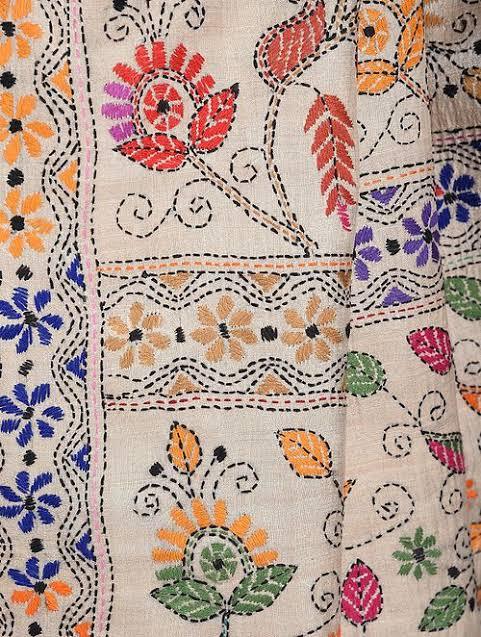




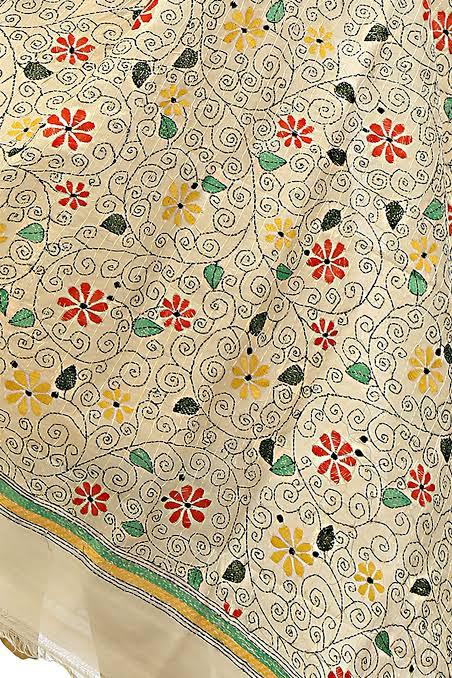

Kantha (Bengali: কাঁথা) is a form of embroidery originating in Bengal region, i.e. Bangladesh and the Indian states of West Bengal, Tripura and parts of Assam. It has its roots in nakshi kantha, an ancient practice among bengali women of making quilts from old saris and rags by sewing them together. In modern usage, kantha generally refers to the specific type of stitch used. The kantha needlework is distinct and recognised for its delicacy. The stitching on the cloth gives it a slightly wrinkled, wavy effect. Today, kantha embroidery can be found on all types of garments as well as household items like pillowcases, bags and cushions.
While it is an increasingly diversifying art form, traditional kantha embroidery motifs are still sought after. Traditional kantha embroidery is two-dimensional and are usually of two distinct types: geometric forms with a central focal point, carried over from the nakshi kantha tradition and influenced by islamic art forms; and more fluid plant, floral, animal and rural motifs with stick-figure humans depicting folklores and rural life in Bengal.
1 / 2 / 3 / 4 / 5 / 6 / 7 / 8 / 9 | textile series
#bangla tag#textiles#ots#kantha#nakshi kantha#bengal#bengali#bangladesh#india#embroidery#needlework#textile art#embroidery art#south asia#south asian
1K notes
·
View notes
Text
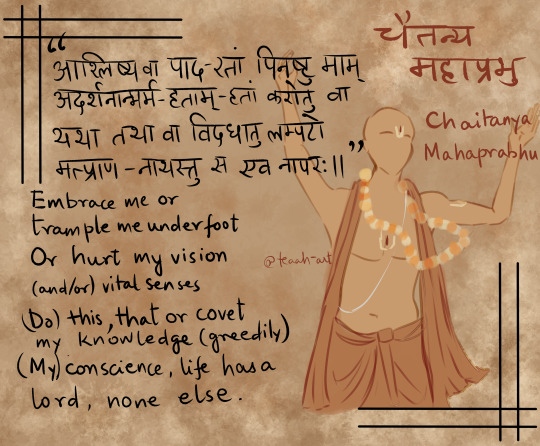



Desi LGBT Fest 2023 (hosted by @desi-lgbt-fest)
Day 7 : Faith/Rituals of Love
Definitely geared heavily towards the 'Faith' part of this prompt as soon as I read it!
If being Queer is defying conventions and if being a part of the Queer community means going against heteronormativity and gender conformity, is it not Queer to forego materialistic ties and the love of a human partner and embrace the love of a greater being you have only heard about in stories?
All four individuals featured here were integral part of the Bhakti Movement and/or Sufism in South Asia. None were married other than Meerabai.
(Panel order from top to bottom)
Chaitanya Mahaprabhu (1486-1534) : A key name of the Bhakti Movement and the Gauriya Vaishnav tradition in 15th Century Bengal, Chaitanya Mahaprabhu was believed to have been a vessel for both Radha and Krishna. Bengali doesn't use pronouns or gendered language and we may never know what they would have preferred to be identified as in a language they didn't know (English), I will simply resort to using They/Them for them. Their written teachings are few and far between but the verse mentioned here is the seventh verse of the only written record of their teachings, the Shikshastakam - a collection of 8 total verses. The translation here is my own and quite literal so that the interpretation is left to the reader.
Meerabai (1498-1597) : [CW : IMPLIED QUEERPHOBIA/APHOBIA] Meerabai was born into Rajput royalty and was married off, also to Rajput royalty, in likely an arranged marriage. While most of the stories surrounding her are folklore whose historicity is yet to be confirmed, her marital status can be confirmed, and so can her devotion and affection for Krishna and the divine, which she has herself penned in numerous poems and songs. Folklore does strongly imply that she was non-committal to her marriage and that her in-laws tried to poison her to death multiple times for it.
Kabir (1398–1448 or 1440–1518) : Found as an orphan by a Muslim weaver couple, Kabir's religion grew to become somewhat of an enigma for future generations. His stance, however, on the topic romance and marital relationships is quite clear - he looked down upon them and a huge chunk of his couplets strongly imply that romantic and sexual relations simply obstruct spiritual enlightenment.
Bulleh Shah (1680-1757) : Bulleh Shah, though an ardent proponent of loving the divine, was declared a Kafir, a non-believer/non-Muslim by a quite a few Muslim clerics of the time. He was known for speaking up against existing power hierarchies of the time and used vernacular speech for his writings (Punjabi, Sindhi) which not only served to popularize his works, but also let people connect to his words.
A personal note on my motivations under the cut.
A while back when I was actively going through the anxiety of finding out that I am ace and that I will never fit into the current South Asian society that the wedding industry has a chokehold on, I desperately wanted to see people from my own culture living happily without a partner. During one of my history rabbit hole escapedes, I restumbled upon the story of Meerabai, how she always insisted on loving and devoting herself towards Krishna, despite being married into a normative and wealthy household and despite her in-laws repeatedly attempting to poison her for not committing to her husband. Most of us from India grow up hearing about Meerabai, her spiritual connections to Krishna, and her struggles. The moral of those stories is always framed as 'believe in god, he will help you through tough times'. But this was the first time I was making a different connection, I was drawing different morals. And when I took Meerabai's non-conformity to her married life and started looking for more examples like hers, I was overwhelmed by how many more individuals existed without a partner, condemned being in a normative, married relationship, admitted to having lost human connections and faced resistance even, and yet stayed true to their orientation and sounded HAPPY! It was extremely hard to narrow it down to these four, but these do make my point! Labels are hard to transpose across cultures and history. But if being queer means being nonconforming of marital structures and being aspec/arospec implies neutrality, indifference, or aversion to romance and intercourse, then no one fits the label if they don't.
#desilgbtfest23#desi lgbt#desi lgbtq fest#long post#pride 2023#pride#original art#my art#meerabai#meera bai#sant kabir#kabir#kabirdas#bullehshah#bulleh shah#chaitanya mahaprabhu#bhakti movement#sufism#sufi#tw implied aphobia#tw mild aphobia#tw implied homophobia#btw if someone notices errors in my Shahmukhi or Gurumukhi on the Bulleh Shah illustration pls let me know#I do not speark or read or write Punjabi and I copied
82 notes
·
View notes
Text
@kathaniii | Aloukik 2023 | Day 2
ఌ︎𝐇𝐎𝐑𝐑𝐎𝐑 𝐅𝐎𝐋𝐊𝐋𝐎𝐑𝐄
🌹☾︎SHAKCHUNNI☽︎🌹


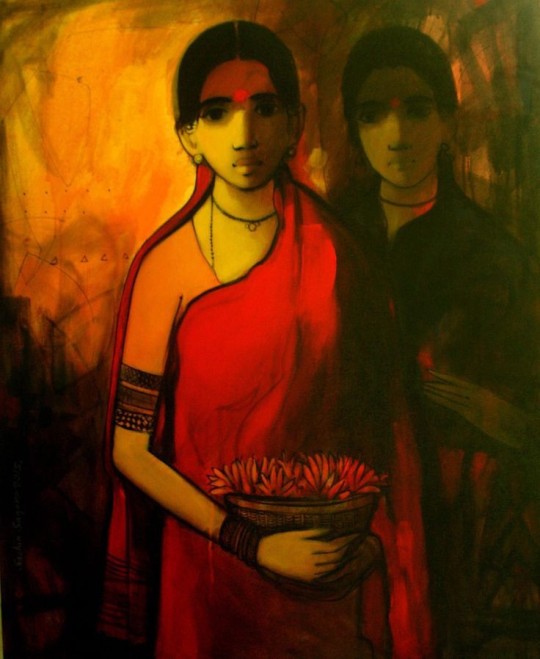

Shakchunni is a ghostly spirit, that's found often in Bengali culture and mythology , she stays in trees , loves fish and likes to trap men into adoring her , absolutely loves adorning Shakha Pola (bangles) and appears as a married women .
Here's a poem to her folklore ( written by me)
Grandma told us don't go into the depths
Of the forest not to the tree of the hanging roots
She lies there , in full brim
For all the ways that you so run into the forest
Never go close to the oldest tree
The tree of green and gold leaves
The tree of hanging like her hair
She lurks into the deep
And if you go near she might have you
And ask you to find her love
And for the love she may not find
She might make your living
Dreadful that you crave death
Grandma told us don't go into the depths
Of the forest not to the tree of the hanging roots
She lies there , in full brim
Leave the jewelleries you find in the forest
Sometimes offer fish
Stay away from her sight unless
you Wanna be friends ,
only you decide if it's worth it
Grandma said us don't go into the depths
Of the forest not to the tree of the hanging roots
She lies there , in full brim .

Thank you
#aloukik 2023#desiblr#desi tag#desi tumblr#desi culture#desi academia#indian academia#desi aesthetic#indian aesthetic
54 notes
·
View notes
Text
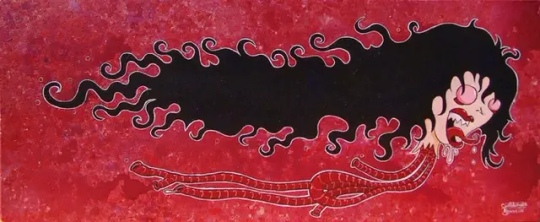
50 Paranormal Creatures From Around The World
Baba Yaga – “In Slavic folklore, Baba Yaga is a supernatural being who flies around in a mortar, wields a pestle, and dwells deep in the forest in a hut usually described as standing on chicken legs.”
Santa Compaña – “The Santa Compaña is a procession of the dead or souls in torment that wanders the path of a parish at midnight involved in white hooded cloaks.”
Deogen – “The Deogen, or The Eyes, is a ghost that is said to haunt the Sonian Forest in Belgium, often seen in fog form and followed by smaller shadow figures.”
Strigoi – “In Romanian mythology, strigoi are the troubled souls of the dead rising from the grave. Some of the properties of the strigoi include: the ability to transform into an animal, invisibility, and the propensity to drain the vitality of victims via blood loss.”
Shubin – “Shubin is the mythological spirit of the mines. The legend of Shubin is distributed mainly in the mining towns of Donbas, Ukraine. The spirit is usually good, but can be wicked.”
Bhoot – “The common word for ghosts in Bengali is bhoot. In Bengal, ghosts are believed to be the spirit after death of an unsatisfied human being or a soul of a person who dies in unnatural or abnormal circumstance.”
Will-o’the-wisp – “A will-o’-the-wisp is an atmospheric ghost light seen by travelers at night, especially over bogs, swamps, or marshes. It resembles a flickering lamp and is said to recede if approached, drawing travelers from the safe paths.”
La Llorona – “La Llorona, or The Weeping Woman, is a widespread legend throughout the region of Hispanic America.”
Teke Teke – “The ghost of a young woman, or school girl, who fell on a railway line and was cut in half by the oncoming train. Now a vengeful spirit, she travels on either her hands or elbows, making a scratching or ‘teke teke‘ sound.”
Nyai Roro Kidul – “A legendary Indonesian female spirit, Nyai Roro Kidul is said to drag swimmers to their death.”
Herne the Hunter – “In English folklore, Herne the Hunter is a ghost associated with Windsor Forest and Great Park in the English county of Berkshire. He has antlers upon his head.”
La Planchada – “La planchada is Spanish for ‘the ironed lady.’ Her ghost appears in many hospitals, though mainly in the metropolitan areas, especially in Mexico City.”
Sihuanaba – “The Sihuanaba is a supernatural character from Central American folklore. She lures men away into danger before revealing her face to be that of a horse or, alternatively, a skull.”
Mae Nak Phra Khanong – “Mae Nak is a well-known and popular Thai female ghost. According to local folklore, the story is based on actual events that took place during the early 19th century.”
Naiad – “In Greek mythology, the Naiads were a type of water nymph (female spirit) who presided over fountains, wells, springs, streams, brooks, and other bodies of fresh water.”
Vodyanoy – “A male water spirit, vodyanoy is said to appear as a naked old man with a frog-like face, greenish beard, and long hair, with his body covered in algae and muck, usually covered in black fish scales.”
Chindi – “In Navajo religious belief, a chindi is the ghost left behind after a person dies, believed to leave the body with the decedent’s last breath. It is everything that was bad about the person.”
Ubume – “In Japanese folklore, an ubume is an old woman or crone, with a child in her arms, imploring the passerby to hold her infant, only to then disappear.”
Krasue – “The krasue manifests itself as a woman, usually young and beautiful, with her internal organs hanging down from the neck, trailing below the head.”
Lemures – “Lemures in Roman mythology are the wandering and vengeful spirits of those not afforded proper burial, funeral rites, or affectionate cult by the living.”
Patasola – “A female spirit from South America, patasola attracts men and lures them to the depths of the rain forest where she turns into a beast and devours the man.”
Jersey Devil – “The Jersey Devil is a legendary creature or cryptid said to inhabit the Pine Barrens of Southern New Jersey, United States.”
Wendigo – “A wendigo is a half-beast creature appearing in the legends of the Algonquian peoples along the Atlantic Coast and Great Lakes Regiaon of both the United States and Canada. It is particularly associated with cannibalism.”
Kallikantzaros – “A malevolent goblin in Southeastern European and Anatolian folklore, the kallikantzaros or its equivalents are believed to dwell underground but come to the surface during the twelve days of Christmas.”
Banshee – “In legend, a banshee is a fairy woman who begins to wail if someone is about to die.”
Estries – “Estries are female vampires of Jewish folklore that were believed to prey on Hebrew citizens, particularly men.”
Hell hound – “A supernatural dog in folklore, the hell hound has mangled black fur, glowing red eyes, super strength or speed, and phantom characteristics.”
Kelpie – “Kelpie, or water kelpie, is the Scots name given to a shape-shifting water spirit inhabiting the lochs and pools of Scotland.”
Bloody Mary – “Bloody Mary is a ghost said to appear in mirrors when a person repeats her name in front of the mirror and turn three times.”
Jinn – “Mentioned frequently in the Quran and other Islamic texts, the jinn are made of a smokeless and scorching fire and inhabit an unseen world, another universe beyond the known universe.”
Dybbuk – “In Jewish mythology, a dybbuk is a malicious possessing spirit believed to be the dislocated soul of a dead person.”
Bélmez Faces – “The faces of Bélmez is an alleged paranormal phenomenon in a private house in Spain which started in 1971 when residents claimed images of faces appeared in the concrete floor of the house.”
Incubus – “An incubus is a demon in male form who, according to mythological and legendary traditions, lies upon sleepers, especially women, in order to engage in sexual activity with them. Its female counterpart is the succubus.”
Hungry ghost – “Hungry ghost is a concept in Chinese Buddhism and Chinese traditional religion representing beings who are driven by intense emotional needs in an animalistic way.”
Buckriders – “According to Dutch folklore, the buckriders were ghosts or ‘devils,’ who rode through the sky on the back of flying goats provided to them by Satan.”
Resurrection Mary – “Resurrection Mary is a well-known Chicago-area ghost story. Of the ‘vanishing hitchhiker’ type, the story takes place outside Resurrection Cemetery in Justice, Illinois.”
Pig-Faced Women – “Stories of pig-faced women originated roughly simultaneously in Holland, England, and France in the late 1630s. The stories told of a wealthy woman whose body was of normal human appearance, but whose face was that of a pig.”
Domovoi – “A domovoi or domovoy is a protective house spirit in Slavic folklore.”
Bell Witch – “The Bell Witch is a poltergeist legend from Southern folklore, centered on the 19th-century Bell family of Adams, Tennessee.”
Bluecap– “A bluecap is a mythical fairy or ghost in English folklore that inhabits mines and appears as a small blue flame. If miners treat them with respect, the bluecaps lead them to rich deposits of minerals.”
Saci – “Best known in Brazilian folklore, saci is a one-legged black or mulatto youngster with holes in the palms of his hands who smokes a pipe and wears a magical red cap that enables him to disappear and reappear wherever he wishes.”
Krampus – “In German-speaking Alpine folklore, krampus is a horned, anthropomorphic figure that punishes children during the Christmas season who had misbehaved.”
Ghoul – “A ghoul is a monster or evil spirit in Arabian mythology, associated with graveyards and consuming human flesh.”
Kappa – “Japan’s kappa are usually seen as mischievous troublemakers or trickster figures. Their pranks range from looking up women’s kimonos, to drowning people and animals, kidnapping children, and raping women.”
Poltergeist – “In folklore and parapsychology, a poltergeist (German for “noisy ghost”) is a type of ghost or other supernatural being supposedly responsible for physical disturbances, such as loud noises and objects being moved or destroyed.”
Tikoloshe – “In Zulu mythology, tikoloshe is a dwarf-like water sprite. It is considered a mischievous and evil spirit that can become invisible by drinking water.”
Egg ghost – “A kind of Korean ghost, an egg ghost doesn’t have arms, legs, or a head, or even eyes, a nose, or a mouth. Legend says that when a person sees an egg ghost, he or she will die.”
Nang Tani – “A female spirit of Thai folklore, nang tani appears as a young woman that haunts wild banana trees.”
Matagot – “A matagot is, according to some oral traditions of southern France, a spirit under the form of an animal, mostly undetermined, frequently a black cat, generally evil, but sometimes helpful.”
Hairy Hands – “The hairy hands is a ghost story that built up around a stretch of road in Dartmoor, United Kingdom, which was purported to have seen an unusually high number of motor vehicle accidents during the early 20th century.”
#50 Paranormal Creatures From Around The World#ghost and hauntings#paranormal#ghost and spirits#haunted locations#haunted salem#myhauntedsalem#paranormal phenomena#hauntings#supernatural#cryptids#ghosts
3 notes
·
View notes
Text
Day 24: Folksong/Folklore
I hope I'm not too late for this prompt, @desi-lgbt-fest!
Since I am a Tamil, Bengali, and Chinese mix, I have three folksongs related to each of them, and they are my current favourites. This goes out for the queer Tamilians, Bengalis, and everybody in between! 🥳🎊✨️
Note: I did read tha the links can not be submitted, so I am gonna be super specific on here so everyone can find the songs.
Tamil: Haratanaya Sree composed by Veena Kinhal; Wikipedia search Saraswati Veena
Bengali: Kolonkini Radha sung by Rishi Chakraborty; On Spotify and YouTube
Chinese: Horse Racing played by the NUS Chinese Orchestra, On YouTube (they play it really well!)
Note Again: I am a sucker for Kolonkini Radha because it's about Radha being warned not to meet Krishna (our beloved queer icon in our LGBT community), but she still does it anyway. I see it as a parallel where us queer people are warned by some of our family members not to follow our hearts, yet we do it.
Enjoy, and happy pride 🏳🌈❤✨
undefined
youtube
#submission#desilgbtfest23#dlf23: day 24#music#this is very cute#adding links on your behalf#SoundCloud#Spotify#Youtube
13 notes
·
View notes
Photo

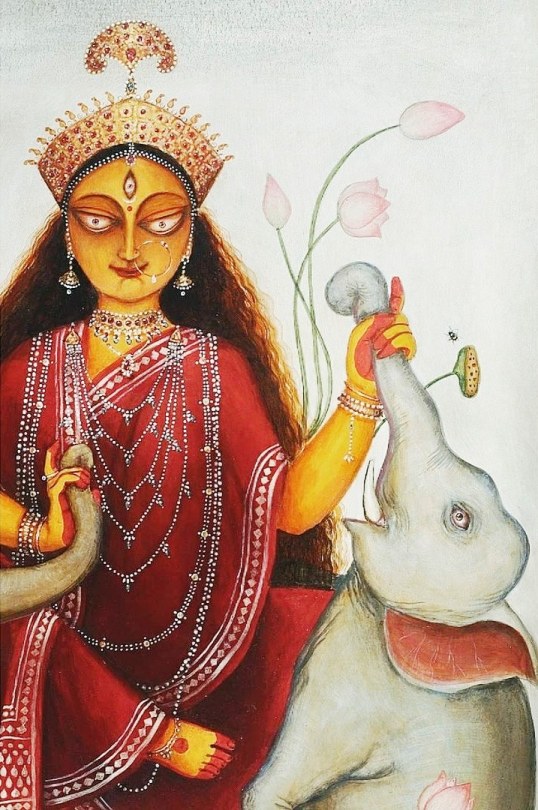

II KamaleKamini II
Artist: Arka Patra. Acrylic painting.
Arka Patra wrote :
According to an old Bengali folklore a ship of sailors on their way to trade in the island of Singhala got lost in the dark mysterious waters of the Indian Ocean.
It is here, in middle of nowhere sprang forth a beautiful forest of lotus blooms, buzzing with bumblebees and teeming with water birds. Fragrant creepers of ‘malati’ , ‘jaati’ and ‘juthi’ flowers were covered with the pollen of lotuses carried by the wind ! The air was abuzz with melodious songs of birds.
In the middle of all this, She is sitting inside a fully blossomed lotus bejeweled and elegant. Her feet was adorned with tingling anklets and the ten nails of her feet shone like ten moons! Her face was radiating glow like the full moon of autumn and the sindur dot on her forehead shone with the brightness of morning sun ! The air had been made fragrant by the lotus like smell of her body and thousands of intoxicated bees were rushing towards her ! And with wondrous amazement they saw that this lady of the lotus is holding an elephant in her hands as it struggles to set itself free.
With perfect ease, the lady lifted the elephant with her left hand and devoured it by swallowing it alive ! And at the very next moment, she regurgitated the elephant and then again tossed it back into the mouth , with the elan and grace of a golden swan ! Sometimes between her act , she was turning her head around to see and smiling to herself. Her teeth shone like flashes of lightening as she hummed ragas and raginis. It was a sight beyond the understanding of God himself !
(via Instagram: Arka_Patra_Art)
85 notes
·
View notes
Text
it appears that today i must be contrarian about everything...if everyone in thai bl fandom blocks me i will understand
but everyone saying that the show has set up an amazing avenue for fanfic authors to explore Phaya and Tharn's past love specifically because they have not explored this story much - im really going to cry because y'all surely weren't talking about international authors - i just need you to understand how difficult it is to plunge my hands into giving context to a love story between a Naga and Garuda.
Where do the Garuda even hang out????? Is he coming down from a kingdom in the sky for his little romp in the forest? Do they live like eagles on trees? Is it another village and they're all some type of human like in the Chinese dramas about immortals??
I mean where the fuck do the Naga live??? Are they just serpents underground??? This is how Naga in Bengali folklore are often portrayed and they are only human when they specifically interact with another human. They were interacting cross godspecies in human form but chalothorn and phaya were fighting in their god form.
Obviously, no one is asking english fanfic authors to make culturally competent stories of the Naga and Garuda but I'm not even talking about that. I'm saying that the easy part of fanfiction is the total lack of worldbuilding you have to do. The fact that I have to even decide in my story if Naga are always hybrid human versus if they're just little snakes when they're up in their crib is just terrible for me as a fanfic writer kjhgfhdgdsfdf
#will this stop me from craving generic fantasy love stories of phaya and tharn in the past?#no it will not i crave it and i wish to write it#the more generic and the less details the better#but you as an author need to keep straight in your head the parameters of your own fantasy world#the less the show gives you the harder it is to write about#this is completely untagged because at this rate im just trying to start fights lol#im not but my actions are consistent with such an interpretation
1 note
·
View note
Text
Hawa" (Bengali): A Haunting Tale of Mystery and Supernatural Intrigue
Hawa," a Bengali movie, ventures into the realm of supernatural mysteries, leaving audiences spellbound with its eerie ambiance and spine-chilling storytelling. Directed with finesse, the film combines elements of horror, suspense, and psychological intrigue to create a captivating cinematic experience. As the plot unfolds, "Hawa" takes viewers on a hair-raising journey through the unknown, exploring the unexplained phenomena that surround its characters, leaving them on the edge of their seats.
Plot Overview: Set against the backdrop of an old and secluded mansion, "Hawa" revolves around a group of characters who find themselves entangled in the clutches of an enigmatic presence. As the eerie occurrences intensify, the house's dark secrets are gradually unveiled, leading the protagonists deeper into a web of terror and mystery. The film masterfully intertwines supernatural elements with psychological drama, keeping the audience guessing at every turn.
Atmosphere of Fear: "Hawa" adeptly builds an atmosphere of fear and suspense, enveloping viewers in an unsettling ambiance that keeps them hooked throughout the movie. The haunted mansion and its ominous surroundings serve as a character in themselves, adding to the tension and eeriness that permeate the film.
Character Psychology: The movie delves into the psychology of its characters, exploring their fears, vulnerabilities, and past traumas. As the supernatural events unfold, the audience is taken on a psychological journey, uncovering the impact of the paranormal on the human mind. This interplay between the supernatural and the characters' psyches adds depth to the narrative, making "Hawa" a multi-dimensional cinematic experience.
Thrilling Moments: "Hawa" is replete with thrilling and terrifying moments that send shivers down the audience's spine. The masterful use of sound, visuals, and suspenseful pacing creates a rollercoaster of emotions, ensuring that the viewers are kept on the edge of their seats throughout the movie.
Cinematic Brilliance: The film's direction and cinematography are a testament to cinematic brilliance, capturing the haunting ambiance and emotions of the characters with precision. The skillful use of lighting, camera angles, and visual effects heightens the impact of the supernatural elements, contributing to the movie's overall haunting appeal.
Bengali Culture and Folklore: "Hawa" embraces Bengali culture and folklore, infusing the narrative with regional myths and legends. The incorporation of local traditions and superstitions adds authenticity to the film, immersing viewers in the cultural backdrop of the story.
Suspenseful Climax: As the mystery deepens and the paranormal encounters escalate, "Hawa" builds towards a suspenseful climax that leaves the audience in awe. The resolution of the enigmatic presence's intentions unfolds in a gripping finale, revealing the truth behind the haunting occurrences.
2 notes
·
View notes
Text
Welcome Traveler
Welcome, hello, salutations, etc.! The name is Kiya, and the game is...tumblr. Doing whatever people do on tumblr. Such as reblogging.
This blog used to be a fandom blog, got converted to a photography blog for a smidge (ie i just rb’d photos), then very briefly became a writeblr before I got *extremely* bored and now it’s a collection of miscellaneous shit I like again + some leftist bullshittery. I primarily write for the fandoms I’m in (when I have time), but I will periodically work on my own stuff when the Inspiration strikes me.
Since I’m getting bored of writing this out, a quick FAQ down below so we can get acquainted:
Any/ All Pronouns
Queer + trans, disabled, Muslim, Bengali
Absolutely zero taste in anything and everything
I either like the most fucked up media on planet earth or the fluffiest shit ever, no in between
Horror movie enthusiast
Fantasy Novel lover
Passionate about obscure historical figures (+ bonus points if queer and/or poc and/or disabled)
Also lover of folklore and mythology
A bit of a gamer- I enjoy interactive fiction (think of those old school CYOA games. Includes text based games and visual novels.) I have an itch basically dedicated to them found here: https://mishtishouse.itch.io/
Ship and let ship. I do not care for shipping discourse. Ship what you want, I’ll ship what I want, done deal.
This blog will mostly be rb’s. If I ever do a post of my own, it’ll probably be some sort of analysis, or promoting my fics.
Speaking of my fics, my AO3 can be found here: https://archiveofourown.org/users/TaiMaiTee. It’s been a while since I posted much of...anything really, but don’t worry, I’m hard at work on a (unedited, equal amounts of angst and absolute bullshit) fic.
Can get pretty quiet the busier I get with school/ work. If on the very rare occasion one of y’all sends me something, please don’t take it personally if I don’t get around to answering you immediately! I love getting asks, though I struggle to reply to them (undiagnosed autism go brrr) and tend to get pretty busy!
Feel free to jump on my blog and say hi!
2 notes
·
View notes
Text
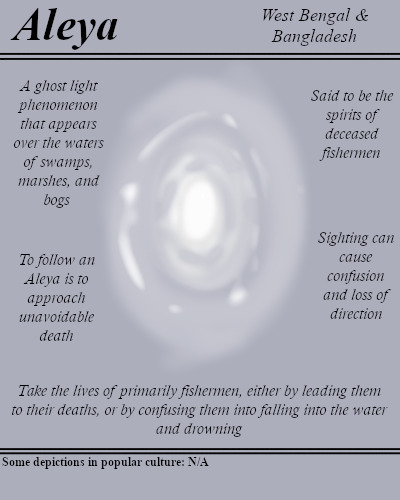
Be wary of flitting lights over the water. In a majority of cases, following these strange lights tends to get you lost, and may possibly even leave you dead.
#BriefBestiary#bestiary#digital art#fantasy#folklore#legend#myth#mythology#aleya#spirit#aleya ghost lights#ghost lights#bengali folklore#west bengal folklore#ghost#ghost light#fishermens' ghosts#undead
6 notes
·
View notes
Photo

Bhoot Chaturdashi or the Halloween for the bengalis has a symbolic reminiscence. . Read the caption below . As per the folklore, the day before the Kali Puja is observed as Bhoot Chaturdashi. The veil between the two worlds is thin and it is believed on the eve of this dark night the souls of the deceased come down to earth to visit their dear ones. It is also believed that the 14 forefathers of a family visit their living relatives and so 14 Diyas are placed all around the house, to guide them homewards and especially to chase away the evil ones (as shown in the picture). . . As a practice, we draw these images of dushtu bhoot (evil ghosts) running out of the house as we light up the diyas around the house. This was done courtesy my cousin maternal sister who is an artist herself. The day is observed across the country in various names like Kali Choudas, Naraka Chathurdasi etc. . . Comment below if you have any similar custom in your home. . . Follow @bongfooodie for interesting stories from across my life. . . #kalipuja #bengalis #indiancustoms #chaturdashi #diwali #diwali2022 #chotidiwali #bloggerlife #incredibleindia #indianstories #storiesfromindia #bengalistories #bengalirituals #celebrations #festivalsofindia #indianfestival #festivals #indiaat2022 #lifeofablogger #blogsfromindia #indiablogger #foodblogger #travelstories #bengalitraveler #thefoodietraveler #travelfoodie (at চেতলা) https://www.instagram.com/p/CkEO2upvbl3/?igshid=NGJjMDIxMWI=
#kalipuja#bengalis#indiancustoms#chaturdashi#diwali#diwali2022#chotidiwali#bloggerlife#incredibleindia#indianstories#storiesfromindia#bengalistories#bengalirituals#celebrations#festivalsofindia#indianfestival#festivals#indiaat2022#lifeofablogger#blogsfromindia#indiablogger#foodblogger#travelstories#bengalitraveler#thefoodietraveler#travelfoodie
5 notes
·
View notes
Text
Keeping my earth shattering imposter syndrome at bay, let's talk about my biggest project ever. Which I probably will never complete. But I love to talk about it.
So like I have this story in my head which I call the fantasy book in my head. Its a asoiaf meets bengal kinda thing. I like to call it grimdark, my friend who I narrated the main premise to said "that's straight up horror dude"
But like yk, bengali folklore and our love of ghosts. The main character is a very complex being (not exactly human, at least not anymore.) My main characters humanity, that died before the start of the story, haunts the narrative and the being she is now.
I'm worldbuilding so hard but like, it's genuine fantasy so a lot of ghosts and of course since my Bangladesh is a riverine country, a lot of river related geography and the rivers are characters of their own.
Also this story came to me in a dream on 23rd November 2014. I was chilling in Dhaka as an 8 year old. A lot has changed since then.
Also the main characters family is basically descended from shath bhai chompa. I'm crazy. And it's a huge plot point.
Also a lot of baghs and well a lot of environmentalism. My mc is a product of environmental manipulation. It's basically mother nature sends you as a fuck you letter to the government.
Also, a "spirit" haunts my main character the whole time (like bikrom betal/vikram betal). And then there's the whole body, heart and soul symbolism.
The prologue chapter starts as a putul nach scenario. Honestly will I ever finish this? Probably not. But if I ever do, will it just be me making jabs at my colonisers, the government and every authority figure there is? Yup. Also a lot of indigenous representation cuz Bangladesh sucks at that. Yeah no wonder I'm going insane. Also my main motivation to write this is to be present at the bengali ghost Wikipedia page at the writer's section.
#valyrianscrolls#asoiaf#bengal#bengali#ghost#web weavings#writers of tumblr#west bengal#banglablr#bangladesh#bangla#bengali literature#bangla shahitto#uponnash#desi#desiblr#desi literature#ar tag pore add korbo ghum ashtese#environment#environmetalists#nature in literature#nature's corrupt daughter#spooky#bangla literature#desi tumblr
1 note
·
View note
Text
Celebrating Diversity: Regional Variations in Indian Traditional Paintings
India is a country with diversity in cultures, languages, and customs; each area adds its own distinct character to the nation's extensive historical fabric. The unique traditional art forms that have developed throughout the nation are one of the most compelling examples of this diversity. Indian traditional paintings are unique among them, providing a visual feast of colours, subjects, and techniques that are specific to each location.
In this blog, we will look at different Indian states and their special contributions to art. From the vivid colours of Rajasthan to the tranquil surroundings of Kerala, every area has its own unique aesthetic that reflects its ethos, history, and culture.
Indian States and Their Popular Painting Styles
Indian paintings are very popular globally for their depiction of culture and mythology. Indian paintings remind us of the love we have for our diverse culture, beliefs, and traditions. All 28 states offer some unique form of art. Let's have a look at some of the Indian states and their popular forms of art.
Rajasthan: The Land of Royalty and Colours
Rajasthan is a state known for its beautiful palaces, long stretches of desert, and rich forms of art like singing, dancing, and painting. The state is well known for its miniature paintings. This style of Indian traditional paintings have gained a lot of popularity globally for its intricate detailing and rich cultural themes.
These paintings usually feature royal portraits, historical events, and mythological scenes. From the vibrant markets of Jaipur to the imposing forts of Jodhpur, each brushstroke depicts a tale of bravery, passion, and extravagance. You can pair these intense paintings with a simple abstract wall art to create an unorthodox focal point in your room.
West Bengal: The Meeting Point of Nature and Emotions
From the north western state of Rajasthan, we now move towards the eastern state of West Bengal. Patachitra and Kalighat art are two renowned forms of art in West Bengal. Kalighat paintings originated in the Kalighat Kali temple around the 19th century and are known for their bold lines and visually striking composition.
In Patachitra paintings, ‘pata’ means fabric or cloth, and ‘chitra’ means drawing or painting. Originally, this style of painting was crafted on pieces of fabric, but later it was drawn on canvas. Patachitra paintings primarily feature depictions of Indian Gods and Goddesses. Bengali paintings arouse feelings of spirituality and appreciation for nature, influenced by the lush landscapes of the Sundarbans and the ethereal aura of the Ganga.
Kerala: The Mythical and Divine Land
From the east now, we move to the Southern part of India, Kerala. Aside from a 100% literacy rate, Kerala is also known for its unique style of painting. This God owned land's love for art is evidently visible in its intricate temple architecture. Its traditional mural paintings represent themes from local folklore and Hindu mythology on the walls of old temples and palaces.
The elaborate details, vivid colours, and expansive compositions of these paintings define them. Kerala murals provide an insight into the rich cultural legacy of the state, showcasing everything from the celestial beings of the Ramayana to the fantastical creatures of Kathakali dance.
Gujarat: A Fusion of Innovation and Tradition
Gujarat, a state in western India, has a distinctive style of traditional painting that combines creativity and tradition. Among the most well-known forms are Pithora paintings and Kalamkari art, which are renowned for their elaborate designs and brilliant colours.
Pithora paintings originated in the Pithoragarh region of Gujarat, where members of the Bhil and Rathwa tribes depicted their tribal culture and beliefs in paintings. Kalamkari paintings are known for their intricate details and delicate curves. They usually depict animals, plants, and God portraits. Gujarati paintings honour the spirit of creativity and workmanship, drawing inspiration from the folk customs and tribal heritage of the area.
Conclusion
As our tour of the many regional variations in Indian traditional paintings draws to an end, we are reminded of the incredible art of creativity and culture that make up our country. Every region has a different take on art and aesthetics, from the tranquil backwaters of Kerala to the royal courts of Rajasthan. These are some of the best wall paintings for the living room if you have a traditional Indian decor.
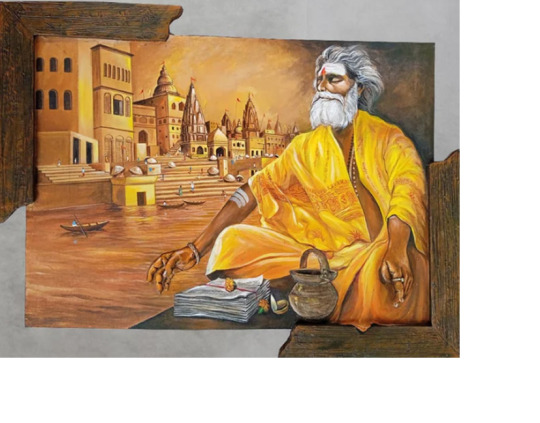
If you are looking to buy Indian traditional paintings for your living room, you can check out Satguru’s. They have an amazing collection of affordable paintings that can serve as amazing focal points in your space. Along with Indian traditional paintings, they also have an amazing collection of Modern art, Spiritual and Landscape paintings. Visit Satguru’s to find a painting that connects with you and your taste.
0 notes
Text
Explore The Versatile Bengali TV Serials Online For A Captivating Experience.
Introduction:-
Bengali television's rich storytelling legacy blends historical culture with contemporary stories to give viewers an engaging experience. The availability of online streaming services like Dangal Play has allowed viewers to immerse themselves in the world of regional and varied Bengali TV serials from any location. Explore the variety and entertainment of Bengali TV Serials Online on Dangal Play, which provides a look into the rich culture of Bengali entertainment.

1. Rich Cultural Heritage: Bengali TV Serials on Dangal Play
Bengali TV serials are well-known for their deeply rooted cultural themes, historical dramas, and literary adaptations that appeal to audiences in West Bengal and outside. Bengali TV Serials Online on Dangal Play provide a unique blend of entertainment and cultural immersion, whether they explore the complexities of Bengali traditions and culture or highlight classic literary works.
2. Varied Genres: From Drama to Comedy and Beyond
The diverse collection of Bengali TV Serials Online accessible on Dangal Play is one of the attractions. Bengali TV shows range from heartwarming family dramas to lighthearted comedies that make viewers laugh and smile, appealing to various interests and inclinations. Some popular genres include:
Family Dramas: Explore the complexities of familial relationships, love, and conflicts.
Historical Dramas: Journey through iconic historical events and legendary figures of Bengal's past.
Romance: Experience timeless love stories set against the backdrop of scenic locales and cultural richness.
Comedy: Laugh along with quirky characters and hilarious situations that bring comic relief.
3. Iconic Characters and Performances
Bengali television series are renowned for their famous characters, brought to life by gifted performers in prominent roles. Bengali TV Serials Online on Dangal Play feature an array of acting skills, from seasoned veterans to up-and-coming performers, which enhances the narrative experience and gives it more nuance and realism. These performances profoundly affect the audience, whether they are portraying historical figures, contemporary heroes, or just ordinary people.
4. Cultural Exploration: Mythology, Folklore, and Traditions
Numerous Bengali television series explore the intricate web of mythology, folklore, and customs that characterize Bengali culture. These programs teach and enlighten viewers about the culture and values that Bengalis hold dear, in addition to providing entertainment. Bengali TV Serials Online on Dangal Play give insight into Bengal's rich cultural diversity, whether they present joyous festivities or delve into legendary stories and folklore.
5. Regional Flavor: Celebrating Bengali Language and Identity
The Bengali TV Serials Online on Dangal Play is unique in that they honor the region's language, dialects, and local subtleties. Viewers enjoy the beauty of Bengali poetry, conversations, and sentiments, which lend authenticity and depth to the drama. For audiences who speak Bengali or are curious about Bengali language and culture, this regional flavor improves the immersion experience.
6. Diversity of Themes and Narratives
Bengali TV Serials Online on Dangal Play features various subjects and tales that speak to current social issues, personal struggles, and human emotions. These shows provide thought-provoking content that appeals to viewers of all ages by tackling societal concerns such as gender equality, empowerment, and education and emphasizing cultural variety and inclusivity.
Conclusion:
Dangal Play provides a treasure mine of diverse and regional Bengali TV serials that promise viewers an engaging and enriching experience. Bengali TV Serials Online on Dangal Play include everything from humorous antics to romantic tales, family sagas, historical dramas, and romances. Dive into the world of Bengali entertainment, discover cultural riches, and enjoy unforgettable narrative moments on Dangal Play today.
0 notes